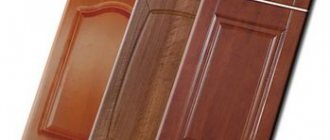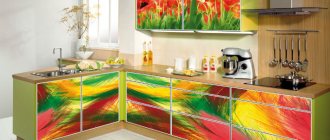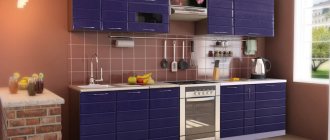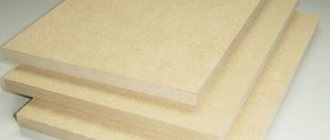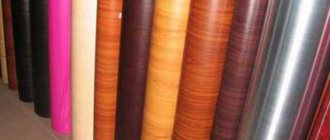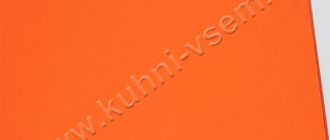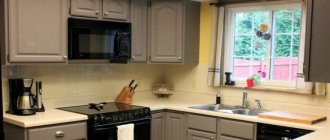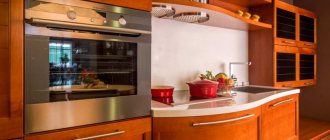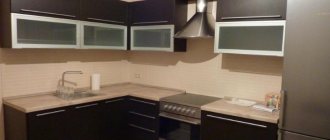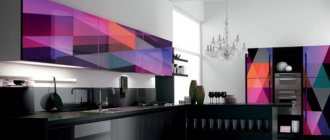68676
Beautiful, functional furniture is a must-have attribute of a home, office or apartment. Cabinet products in furniture production are decorated with facades treated with film material. A coating such as PVC film for furniture facades protects elements from moisture, scratches, damage and has an important decorative function. The coating allows you to implement many interesting ideas and design projects.
Technical characteristics and advantages of VVC film
The main purpose of polyvinyl chloride film is to give the furniture facade durability and an aesthetically attractive appearance. It harmonizes perfectly with any interior, as you can choose it to your own taste.
Film for cladding furniture facades is produced in thicknesses from 0.15 to 0.8 mm, width 1.40 m, in rolls, linear length from 100 to 500 m. The material has a number of positive performance properties:
- rigidity and strength, along with high elasticity;
- moisture resistance;
- low thermal conductivity;
- resistance to chemical influences;
- environmentally friendly - the material does not contain or emit harmful substances.
The advantages of film for cladding furniture facades also include:
- resistance to mechanical stress - scratching, abrasion and cracking;
- resistance to temperature changes and high humidity;
- resistance to ultraviolet rays - it does not fade and does not change the original color scheme, and as a result, it is not subject to aging;
- the film undergoes antifungicidal and antibacterial treatment;
- it is much more affordable than other facing materials.
It is impossible not to note the high aesthetic qualities - it is given relief and structural forms of various configurations, high-quality printing and varnish coating are used. It allows you to implement different design solutions and gives a special decorative effect to the surface of the furniture.
Pros and cons of using
PVC film for furniture facades has a number of significant advantages:
- combination of strength with high elasticity, which prevents tearing of the material during use;
- water resistance;
- low thermal conductivity;
- resistance to many chemicals, deformation, heat and cold;
- there is no fading because the material is impervious to ultraviolet radiation, that is, even when exposed to direct sunlight it will not fade;
- favorable cost, especially in comparison with simulated materials - stone, wood, marble;
- high-quality drawings, interesting textures, impressive appearance of films.
Due to its resistance to moisture and heat, PVC can even be used in the interior of a kitchen or bathroom, where other materials would quickly begin to deteriorate.
However, one cannot fail to note the possible disadvantages:
- self-adhesive PVC film may begin to peel off or bubble if it cannot withstand constant changes in temperature, humidity, and direct rays of the sun;
- sometimes it breaks or is accidentally cut with a knife, then the coating cannot be restored or a separate fragment can be replaced without losing aesthetic qualities, everything has to be re-glued.
Types of facades for furniture, options for their design
In order not to spoil the self-adhesive PVC film, it is better not to clean it with abrasive materials (a sponge with soapy water is perfect), do not cut anything on it with sharp objects, do not expose it to too much heat or cold, or sudden changes temperature. Despite the fact that it must withstand this, its service life will increase significantly if these simple rules are followed.
Application technology
In modern furniture manufacturing technology, three methods are used for covering facade parts with decorative PVC film - lamination, lamination and post-forming.
- Lamination is a technique that requires high temperatures and pressure. Individual parts of the furniture to which the film is applied are exposed to this effect. The surface of the parts is evenly covered with a protective layer and becomes highly durable and waterproof;
- Postforming - this method is used when using layered types of material. Its peculiarity is that an even film without a textured pattern is applied to the part. All the originality of the form is achieved precisely during post-formation. The material is pressed against the part by a press that has the desired relief pattern or a given shape, which is transferred to the protective coating. This method allows you to obtain surfaces of particular strength and , for example, kitchen countertops;
- Laminating - this technique is distinguished by the fact that special glue is applied to the part being processed in advance and a film is applied, and then the product is placed under a vacuum press. Under the influence of pressure and temperature, the decorative layer is tightly pressed and glued to the part. Such products are less resistant to external influences, although visually they may not differ from laminated ones. The advantage of this technology is its low cost compared to others.
Variations of PVC materials
Vinyl films, as the main group of products made from polymerized vinyl chloride, are classified according to areas of application:
- For a membrane-vacuum press: thickened film material is used to cover three-dimensional objects with a relief surface. (For example, doors, decorative furniture, countertops)
- For lamination of smooth surfaces: in demand when covering large non-relief straight objects. PVC film for MDF and chipboard panels is thin. (This could be a window sill, inner walls of cabinets, oblong panels)
- For covering molded products: suitable for laminating objects made of any organic and inorganic materials, including wood, metal, vinyl chloride. With the addition of acrylic it is used for covering window and door profiles, baseboards.
Main types of PVC films
Decorative vinyl film coatings are divided into several types, depending on the technology of their application.
Film for membrane-vacuum pressing
It is intended for textured surfaces of furniture facades made of MDF - these are doors, shelves, countertops and other elements. The process is carried out using a special vacuum press. The film has a thickness of 0.25 to 0.5 mm. They use both plain types and with various patterns or imitation of the textures of natural materials.
Video: “Vacuum presses for cladding furniture facades”
Film for laminating smooth surfaces
This type is well suited for cladding smooth surfaces made of fiberboard or MDF, for example, furniture panels, doors, window sills. Not all types of films are suitable for laminating chipboard due to the structural features of the boards themselves. In this case, the thinnest coatings are required, with a thickness of only 0.2 - 0.3 mm.
For lamination of profile moldings
When working with profile molded products, a machine is used to wrap long parts with film. A special laminate material with a thickness of 0.3-0.5 mm is used.
A similar technology is used to coat products made of metal, wood, plastic and MDF. In some cases, two-layer PVC films are used for lamination, which have additional protection from ultraviolet radiation.
Video: “Line for laminating furniture facades with PVC film”
Clear Protective Film for Furniture
For temporary protection of surfaces, a transparent soft PVC film with a thickness of about 50 - 120 microns is used - it stretches well and is convenient to work with.
It is indispensable when transporting furniture or other products, both disassembled and assembled. It is clear that the thicker the material, the higher the degree of protection of the parts. A special glue applied to one of the sides reliably fixes the film on the surface, but does not leave any marks on it when removed.
Often, inscriptions, logos or drawings are applied to such a coating for advertising or warning purposes.
For finishing the edges of chipboard and MDF panels
To reliably protect the ends of furniture parts, which are often subject to significant impact loads, as well as to give them an aesthetic appearance, a special PVC edge film is used. It combines the qualities of elasticity and hardness, but gluing it yourself is quite difficult, since this cladding should ideally be attached using a special machine. At home, a hair dryer and good thermal glue are used for this. The edge fits equally well on both chipboard and MDF.
What is PVC film
PVC film is a thermoplastic polymer polyvinyl chloride, which is made from granular polymer material. It is processed in a special machine and then melted. Then they shape the polymer and make cuts of the required length and width. The finished polyvinyl chloride film is a durable, durable material. This highly stretchable fabric does not deform and is absolutely waterproof, resistant to fats, soot and chemical compounds, and can withstand both high and very low temperatures.
Application
Polyvinyl chloride film has a wide range of applications in a wide variety of areas. It is most often used in construction, medicine and pharmacology, the food and chemical industries, and in the manufacture of consumer goods.
- For the manufacture of packaging materials in which various foods are later wrapped, protecting them from moisture and dust.
- Various advertisements are printed on PVC film on the glass of buildings and vehicles.
- You can make a high-quality print of any design or ornament on the surface. Therefore, the material is often used in interior design.
- This material is very convenient for finishing furniture, cladding walls, floors, suspended ceilings, facades.
- The canvas is excellent for waterproofing the foundation of a house, as it is absolutely waterproof.
- Used for laminating MDF surfaces.
- Using polymer film, you can easily make a homemade small pond or swimming pool.
- Plastic also contains polyvinyl chloride. Plastic bottles with any liquid, caps, containers, and lids are made from it.
Colors and texture of PVC films for furniture facades
The texture and color of the film determines the overall appearance of the furniture facade, so manufacturers have mastered the production of a huge number of different types. It can imitate natural materials, be plain or with numerous decorative designs, colorful or embossed. Thus, transparent, matte and glossy, embossed and textured, mother-of-pearl or “chameleon”, patterned or “metallic” and many other types are produced.
The color range probably includes all existing shades - from the lightest to almost black in the entire diversity of the spectrum. Coatings that imitate shagreen, silk, rare woods, genuine leather, polished natural stone, etc. look very nice.
Paintwork hazards in descending order
- Gravel from under the wheels. It always flies, especially from under trucks. Leaves small chips on the front bumper, hood, headlights. Sometimes it penetrates to the metal.
- Sandblast. There is a sandy suspension on the road, dust through which you can drive at a speed of 130 km/h. Makes the paint evenly cloudy.
- Accident. A fallen twig, a pebble from the facade, or a driver who parks carelessly. Minor accident.
- Winter reagents. Salts and various additives that prevent the formation of ice.
- Acid rain. Of course, we don’t live in Pripyat, but nevertheless, not every rain has a neutral pH factor.
- Self-wash. There are two dangers. Or a contact washing method in which you can scratch the body due to inexperience. Or leave the car after washing in the sun, where every droplet will act as a magnifying glass and try to damage the varnish.
- Bird droppings. Without going into the chemical composition of bird droppings, the danger is this: first, microcracks appear on the surface, which subsequently increase. Plus the birds have claws and scratch the roof and hood.
- Cats. Cats can bask on the cooling hood. And since it is slippery, it is more difficult to hold on. You can't do without claws.
Some detailing studios do not consider vinyl film to be protective.
But if we put aside the lyrics, the film performs some protective functions. Yes, significantly lower than polyurethane. Still protects. Therefore, it is best to cover your car with vinyl protective film for a short period of time. For example, for the duration of a long car trip, and then remove it. If you want to protect your car for many years, then you undoubtedly need to choose the option of wrapping it in polyurethane protective film.
To make it easier for you to decide which film to cover your car with, we will compare. In comparison, the material seems much lighter.
Some definitions from the table:
Self-healing - a regenerating layer. Polyurethane film has these properties. If it is heated to a temperature of 60 °C, then it is leveled, i.e. if there is a dent or a shallow scratch on the film, it is tightened.
An accident - a small branch falling from a tree, a minor accident at an intersection, bad parking. It is clear that everything is relative. Here's an example.
Clouding and yellowing - usually more pronounced on glossy clear vinyl film, after 1-2 years of use. It's not so visible on matte. Therefore, in order to save money, some drivers use matte transparent film. Polyurethane does not have this problem for the first 5-7 years.
Shagreen - an uneven surface, ribbing of the film, like the effect of an orange peel. For example, the glare of the sun with shagreen is uneven.
Ultraviolet - uniform burnout of varnish under the film. Vinyl film does not transmit ultraviolet radiation. For example, if you covered only the front of the car with vinyl film, then the natural fading of the paintwork will occur unevenly. After removing the film from the hood after 3 years, you will notice a difference in color between the previously pasted elements and those that were not pasted over. Polyurethane film transmits ultraviolet radiation, so fading will occur evenly and there will be no color difference after removing the film. Therefore, it is better to cover the entire body with vinyl film, while polyurethane film allows for partial pasting.
Leading manufacturers of PVC film for furniture facades and material prices
Similar technological material is produced in many countries, most of which supply it to the Russian market. If desired, among the huge assortment you can always choose the desired shade and texture. The following brands are in particular demand:
- The Italian company ALFATHERM selection of colors and textured patterns of Alfawood film for furniture decoration. The company specializes in calm, natural motifs and shades, which allows you to create harmony in any interior. The cost of vinyl film, depending on the specific type and volume of delivery, varies from 100 to 350 rubles. per sq. meter.
- The Russian market has been flooded with inexpensive products from numerous Chinese, “Foshan Nanhai”, “Huangshan City Dongyi”, “Premium” series, which are used in membrane-vacuum pressing. This is the case when the product is really high quality. Despite the fact that production is located in East Asia, such film coating often has a European design and can be purchased for 50-100 rubles;
- Concerns LG HAUSYS and Dae Yang Co. (Korea) are guided by European fashion trends. They produce a wide range of film products, which are dominated by imitations of various types of wood and stone, as well as velvet, silk, mother-of-pearl surfaces and unusual fantasy decors. The cost of products from South Korean manufacturers ranges from 80 to 200 rubles per square meter. meter;
- German film from KLÖCKNER PENTAPLAST and RENOLIT of the “Prestige” class is also very popular and in demand among manufacturers of furniture, doors and windows. In the “Prestige” series you can find samples in classic or extravagant styles, from the simplest to the ultra-modern. Companies follow the latest fashion trends and try to adhere to these trends. Such products are perhaps the most expensive - their price can reach 400 - 450 rubles.
Also on sale are samples of film products for facades from Russian, Israeli, Spanish and other manufacturers with prices ranging from 70 to 400 rubles per sq. m. meter.
Thanks to the use of vinyl coverings, a revolution has literally occurred in the furniture industry. It has become possible to implement the most daring design ideas without much difficulty and create interior items that are practically no different from those made from natural materials. It is not surprising that the demand for such material is growing every year.
How to choose PVC film
When choosing a film, you should focus on the purpose for which you need this purchase. Each type of material has its own clear purpose. Each manufacturer has its own quality, its own cost of goods. You can order goods online and make a sale in the online store. In the catalogs you can consider all possible options, and then arrange delivery to your home by mail. PVC material is sold by weight. If you buy film in bulk, you can get a discount. Online stores also often have promotions and sales.
Application.
- Used for electrical insulation of wires and cables, production of sheets, pipes (mainly chlorinated polyvinyl chloride), films, films for suspended ceilings, artificial leather, polyvinyl chloride fiber, polyvinyl chloride foam, linoleum, anti-splash mats, shoe plastic compounds, furniture edges, etc. Also used for production of vinyl records, profiles for the manufacture of windows and doors.
- Polyvinyl chloride is also often used in clothing and accessories to create a leather-like material that is smooth and shiny. Such clothing is widespread in alternative fashion trends, among members of the gothic subculture and supporters of sexual fetish.
- Polyvinyl chloride is used as a sealant in household refrigerators, instead of relatively complex mechanical seals. This made it possible to use magnetic seals in the form of magnetized elastic inserts placed in a seal cylinder.
- Washable wallpaper is covered with PVC film on the front side in order to make it waterproof.
- It is also widely used in pyrotechnics as a source of chlorine, necessary to create colored lights.
- Widely used in advertising: for decorating shop windows and retail outlets, creating advertising banners and posters. Serves as a raw material for the production of various types of products from records and posters to stickers. A layer of PVC covers the metal mesh of the octagon, where MMA competitions are held. PVC is also used to make condoms for people with latex allergies.
- Polyvinyl chloride is used in the production of knitted work gloves for applying various patterns to the knitted base. The PVC pattern on the glove allows for a good grip when performing various jobs, prevents slipping, and increases the wear resistance of the product.
- Polyvinyl chloride is used to produce chlorinated polyvinyl chloride, which has the highest fire resistance characteristics and the highest flash point (482°C) among thermoplastics.
Areas of application of the material
The scope of application of the material depends on the characteristics of a particular brand. PVC fabric is used in a variety of industries:
- Transparent material is characterized by plasticity, elasticity, resistance to bending and abrasion, and durability. Can be used for awnings and awnings, as curtains for verandas, gazebos and terraces, as an alternative to glass windows. Advertising signs are often made from this film.
- High-density canvas (up to 900 g per sq. m) is suitable for the manufacture of car awnings. The material does not require additional painting, is easy to clean, protects the body from corrosion and weather conditions, and serves in a wide temperature range.
- Sports and children's equipment is made from polyvinyl chloride fabric, for example, trampolines, “cheesecakes” for sliding downhill, inflatable attractions, and play complexes. In this case, special requirements are imposed on the material in terms of safety and wear resistance.
- The material is used for the manufacture of frame structures, for example, tourist tents. In the tourism industry, PVC film is also used for the manufacture of inflatable boats and other types of water transport.
- Consumers have already appreciated hiking clothes, special shoes and fishing equipment made from polyvinyl chloride. Manufacturers produce stationary and collapsible swimming pools for summer residents.
- PVC fabric has found its application in the field of construction and repair, where it is used for the production of suspended ceilings. The film in this case is made by the calendering method, when a molten mixture of PVC granules is passed between 2 rollers. The surface of such a ceiling can be matte, glossy or satin.
- The fabric is used to make bags for bulk mineral mixtures used in construction. In the same industry, film is used as a thermal protective covering material.
- In agriculture, temporary storage facilities are constructed from polyvinyl chloride fabric in the field for storing agricultural products and building materials.
- In the oil and gas industry, this material is used to make shelters for drilling rigs.
- Canopies are made from fabric to protect construction sites in case of precipitation.
You can often see PVC advertising banners on city streets. The strength of the material allows you to create huge advertising areas. At the final stage, the desired design is applied to the fabric using large-format printing.
Description of PVC material
PVC material is hard to the touch and has a high density. This is a two-face fabric with no back side. The canvas is painted in a single color, the surface of the fabric is often shiny. Polyvinyl chloride appeared randomly as a result of an experiment by a chemist. This happened in France more than a century ago. PVC began to be produced on an industrial scale in 1931. In a short time, the then new material began to be used in many industrial areas.
